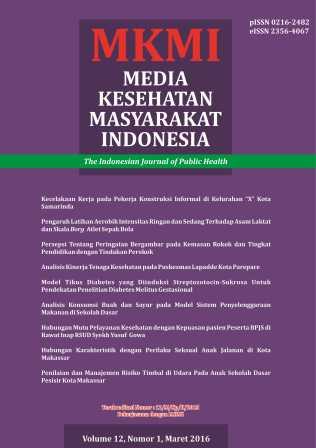MODEL TIKUS DIABETES YANG DIINDUKSI STREPTOZOTOCIN-SUKROSA UNTUK PENDEKATAN PENELITIAN DIABETES MELITUS GESTASIONAL
Abstract
References
Zhang H, Zhang J, Pope CF, Crawford LA, Vasavada RC, Jagasia SM, Gannon M.. Gestational diabetes mellitus resulting from impaired β-Cell compensation in the absence of FoxM1, a novel downstream effector of placental lactogen. Diabetes 2010;59:143–152.
Adam JMF. Klasifikasi dan kriteria diagosis diabetes melitus yang baru. Cermin Dunia Kedokteran. 2000;127:37-40.
Lowdermilk DL, Perry SE, Bobak IM.. Maternity nursing. Edisi ke-5. St. Louis : Mosby; 1999
Sutanegara D, Darmono, Budhiarta AAG. The epidemiology and management of diabetes mellitus in indonesia. Diabet Res Clin Prac. 2000;50(2):S9-S16.
Purnamasari D, Waspadji S, Adam JMF, Rudijanto A, Tahapary D. Indonesian Clinical Practice Guidelines for Diabetes in Pregnancy. JAFES. 2013;28(1):9-13.
Ferrara A.. Increasing prevalence of gestational diabetes mellitus: A public health perspective. Diabetes Care. 2007;30(2).
Bellamy L, Casas JP, Hingorani AD, Williams D. Type 2 diabetes mellitus after gestational diabetes: a systematic review and meta-analysis. The Lancet. 2009;373(9677):1773 – 1779.
Hirst JE, Greenow CHR, Jeffery HE. A systematic review of trends of gestational diabetes mellitus in Asia. Journal of Diabetology. 2012;3(4).
Etuk EU. Animals models for studying diabetes mellitus. Agric. Biol. J. N. Am. 2010; 1(2):130-134.
Koolhaas JM.. The Laboratory Rat Chapter 22. Di dalam: Hubercht R, Kirkwood J, editor. The UFAW Handbook on The Care and Management of Laboratory and Others Research Animals. Wheathampstead (UK). Wiley-Blackwell; 2010
Hellerstrom C, Swenne I, Erikkson UJ. Is there an animal model for gestational diabetes?. Diabetes. 1985;34(2).
Rantam FA.. Metode Imunologi. Cet.1. Surabaya (ID): Airlangga University Press; 2003.
Jung JY, Lim Y, Moon MS, Kim JY,Kwon O. Onion peel extracts ameliorate hyperglycemia and insulin resistance in high fat diet/streptozotocin-induced diabetic rats. Nutrition and Metabolism. 2011;8(18).
American Diabetes Association. Standards of medical care in diabetes . Diabetes Care. 2015;38(1):S1-S94.
Junod A, Lambert AE, Stauffacher W, Renold AE. Diabetogenic Action of Streptozotocin: Relationship of Dose to Metabolic Response. The Journal of Clinical Investigation. 1969;48:2129-2139.
Szkudelski T. The mechanism of alloxan and streptozotocin action in B cells of the rat pancreas. Physiol. Res. 2001;50: 536-546.
Garvey WT. Glucose transport and NIDDM [ulasan]. Diabetes Care. 1992;15(3).
Mayfild JA, White RD. Insulin therapy for type 2 diabetes: rescue, augmentation, and replacement of beta-cell function. American Family Physycian. 2004;70(3).
Cao D, Lu H, Lewis TL, Li L. Intake of sucrose-sweetened water induces insulin resistance and exacerbates memory deficits and amyloidosis in a transgenic mouse model of Alzheimer disease. The Journal Of Biological Chemistry. 2007;282(50):36275–36282.
Chicco A, D’Alessandro ME, Karabatas L, Pastorale C, Basabe JC, Lombardo YB. Muscle lipid metabolism and insulin secretion are altered in insulin-resistant rats fed a high sucrose diet. J Nutr. 2003;133: 127-133.
Daly M. Sugars, insulin sensitivity, and the postprandial state. Am J Clin Nutr:2003;78:865S–72S.
Pagliassoti MJ, Gayles EC, Podolin DA, Wei Y, Morin CL. Developmental stage modifies diet-induced peripheral insulin resistance in rats. Am. J. Physiol. Regulatory Integrative Comp. Physiol. 2000;278: R66–R73.
Calcutt NA.. Modeling Diabetic Sensory Neuropathy in Rats. Di dalam: Luo ZD, editor. Pain Research: Methods and Protocols. New Jersey (US). Humana Press; 2004.
Archer ZA, Rayner DV, Rozman J, Klingespor M, Mercer JG.. Normal distribution of body weight gain in male sprague-dawley rats fed a high-energy diet. Obes Res. 2003;11:1376-1383.
Russel-Jones D, Khan R.. Insulin-associated weight gain in diabetes--causes, effects and coping strategies. Diabetes Obes Metab. 2007;9(6):799-812.
Authors
Authors retain copyright and grant the journal right of first publication with the work simultaneously licensed under a Creative Commons Atribusi-NonKomersial-BerbagiSerupa 4.0 Internasional License that allows others to share the work with an acknowledgement of the work's authorship and initial publication in this journal.
Copyright encompasses rights to reproduce and deliver the article in all form and media, including reprints, photographs, microfilms and any other similar reproductions, as well as translations. The reproduction of any part of this journal, its storage in databases and its transmission by any form or media, such as electronic, electrostatic and mechanical copies, photocopies, recordings, magnetic media, etc.
All articles published Open Access are free for everyone to read and download. Under the CC-BY-NC-SA license, authors retain ownership of the copyright for their article, but authors grant others permission to use the content of publications in Media Kesehatan Masyarakat Indonesia Universitas Hasanuddin in whole or in part provided that the original work is properly cited. Users (redistributors) of Media Kesehatan Masyarakat Indonesia Universitas Hasanuddin are required to cite the original source, including the author's names, Media Kesehatan Masyarakat Indonesia Universitas Hasanuddin as the initial source of publication, year of publication, and volume number.
Media Kesehatan Masyarakat Indonesia Universitas Hasanuddin is licensed under Creative Commons Atribusi-NonKomersial-BerbagiSerupa 4.0 Internasional.


